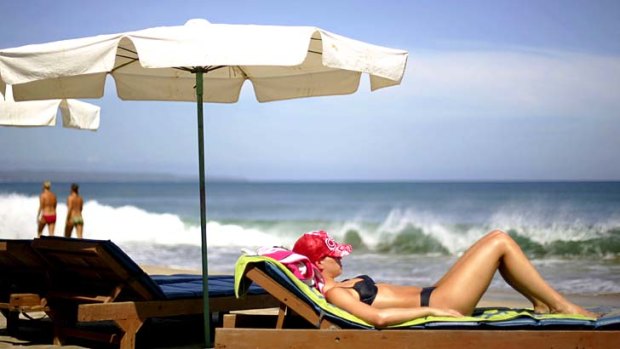
There are so many other beautiful islands in the world - not to mention 17,000 other islands in Indonesia - but tourists continue to travel to Bali in their millions.Credit: Getty Images
Natural riches and a robust, timeless culture have given Bali the strength to rebuild a thriving tourist scene since a bomb struck Kuta in 2002, writes Michelle Jana Chan.
The morning light was blurred by the smoke of wood fires. Out of the haze an old woman came along the road carrying upon her head a shallow woven basket, the kind filled with marigolds, fragrant shredded palm leaves and a few grubby rupiah notes. She made her way to a roadside temple and passed through the carved stone gateway. I watched her vanish behind the grey wall to make her offering of the day. Behind her, a trail of other women followed, also carrying out the dawn ritual.
It is to witness timeless scenes like this which is Bali's greatest draw. Spirituality here runs deep, as well as the age-old customs that attend the syncretism of Hinduism, Buddhism and animism. The rich culture - of exuberant art, of the power of healing and intimate coming-of-age ceremonies - is abundant and visceral, not the sort to be encased in museums.
That is why, when there are so many other beautiful islands in the world - not to mention 17,000 other islands in Indonesia - tourists continue to come here in their millions. That is also in spite of a tough decade which began in 2002 with the devastating terrorist attack in Kuta, as well as subsequent strikes there in 2005 and in Indonesia's capital, Jakarta, in 2009.
Bali bounces back again and again, and that is because it is unique in its compact cultural and physical landscape. In the north are two big volcanoes, Agung and Batur, which enrich the land with fertile soil and irrigate crops with run-off; unsurprisingly, locals regard both mountains as supremely sacred. Cut into the hilly landscape are some of south-east Asia's classic terraced landscapes; there are impressive surfing beaches and spectacular rocky cliffs overlooking the Indian Ocean.
In the northwest, Bali Barat National Park and the adjoining marine conservation area has kept this corner a haven for wildlife: I awoke to see a herd of deer knee-deep in the shoreline; that same evening, on a night dive, I watched the touching courtship ritual of a pair of tiny mandarin fish.

Cultural heart ... Ubud in Bali.Credit: AFP
It is also a place to party, of course; some call Bali the Balearics of south-east Asia. A few days earlier there had been a fashion show at the W Retreat & Spa in Seminyak, where I chinked cocktail glasses with a group of Australians taking a break after the Melbourne Cup; one told me it was because of the bombing in Kuta, not in spite of it, that they had chosen to come here. "We have to remember what happened," he said, referring to the attack which killed 88 Australians and 202 in total. "The best way to remember is to keep coming back."
Seminyak
When tourists have grown up and out of Kuta - the budget travellers' destination - they graduate to upmarket Seminyak. Here are excellent restaurants, including the Starfish Bloo in the W Retreat & Spa, as well as bars such as Ku De Ta and Potato Head Beach Club. The shopping is also some of the best in south-east Asia, with boutiques selling kaftans, white cotton dresses, stylish men's T-shirts and beaded beach bags. Surprisingly, perhaps, the beach here is not particularly beautiful and the sea can be rough. It is perfect for surfers, though, and Quicksilver and Rip Curl both have schools in the area.
Best for dining, drinking and dancing; a 24-hour lifestyle; travelling with a group of friends; shopping trips; surfing.
Where to stay the W is the trendiest place in town, playing dance music or chill-out tracks throughout the day and hosting fashion shows/model shoots.
The remote northwest
A refuge for both wildlife and wildlife-lovers, Bali Barat National Park is home to wild deer, boar and macaques, as well as the blue starling, with its white plumage and startling blue eye make-up. There is also bountiful marine life in the protected waters offshore. Menjangan Island is one of the best places in Bali for snorkelling and diving, with huge schools of batfish, giant trevally and jacks. Closer to the mainland, there is a reef where there is a good chance to see the courtship ritual of the mandarin fish, an endearing, elaborate romp between a female and her suitors.
Best for diving; birdwatching; getting away from it all. The northwest tip of Bali is a half-hour ferry ride to Java, opening up travel to, for example, the Buddhist monument Borobudur. The rainy season is shorter here than in other parts of Bali, extending the tourist season to include April and November.
Where to stay Menjangan Beach Resort has opened a string of beach villas and offers nature walks and guided dives on the house reef, home to resident mandarin fish.
The rural northeast
Close to the flanks of Mount Agung (which last erupted in 1963), this area boasts some of Bali's most fertile land and is noted for growing some of the best mangoes in Indonesia. The beaches have black sand but very calm waters, and there are regular dolphin-watching trips to spot huge pods offshore.
All along the coastline are fishing villages adhering to traditional customs. A good guide is especially helpful to talk visitors through religious ceremonies, from the three-month celebration after a baby is born (when the baby's foot touches the ground for the first time) to tooth-filing ceremonies and cremations.
Best for dolphin-watching; witnessing traditional village life; access to climbing Agung and Batur.
Where to stay the seafront Spa Village Resort Tembok (over 16s only) has beautiful grounds and an exceptional spa reflecting ancient Balinese traditions.
Cultural heart Ubud
The island's cultural capital first made its name internationally back in the early 20th century when foreign artists arrived and exchanged ideas and inspiration with local painters and sculptors. Nowadays, the town is stocked with art museums and galleries (see inset box: Art of Bali), and those with a keen eye will find good-quality woodcarving, silverware, textiles, paintings and sculpture. Regular musical and dance performances take place in the evenings.
The town itself is spread out across a number of parallel river valleys chopped up by rice terraces. Getting around is best by bicycle or scooter. Many bemoan how busy the town has become in recent years, but it still retains an aura - or taksu as locals call it - and the town continues to draw anyone wanting to learn more about the alluring mysticism of Bali.
Best for art museums; shopping for arts and crafts; treks to local villages among rice fields; getting under the skin of Balinese culture.
Where to stay A number of high-end hotels perch above the glorious terraced ravine - coursed by the Ayung river - including the Samaya, the Royal Pita Maha, Amandari and Como Shambhala Estate. All these hotels are a 10-minute drive from downtown (and run complimentary shuttle services), and may be a smart choice for longer stays. For briefer trips, Komaneka has two well-priced, centrally located properties including the newest, Komaneka Rasa Sayang.
The five-star south
In times past, one of Bali's most popular and convenient destinations was Nusa Dua, close to the airport, with top-notch accommodation fronting Geger beach. Since then, hotels have become supersized - like the Mulia, opening this year with 745 rooms - and the area is focusing on the business of conferences.
Further south are a growing number of more secluded properties on this anvil-shaped promontory known as the "bukit", with its dramatic clifftop views across the Indian Ocean. The beaches are rocky and most of the hotels do not recommend swimming in the sea. Don't miss a seafood meal at the nearby warungs or low-key local beachfront restaurants at Jimbaran Bay.
Best for anyone seeking R&R; dramatic clifftop views; honeymooners, and those who enjoy the privacy of a pool villa.
Where to stay the Alila in Uluwatu has breezy open-plan rooms, one of the best spas on the island and a fantastic Indonesian restaurant called Warung; villas at the Banyan Tree Ungasan have more spectacular views and direct access (down 100 steps) to a wild sandy beach with crashing waves.
The writer travelled as a guest of Western & Oriental.
- The Telegraph, London
Sign up for the Traveller Deals newsletter
Get exclusive travel deals delivered straight to your inbox. Sign up now.